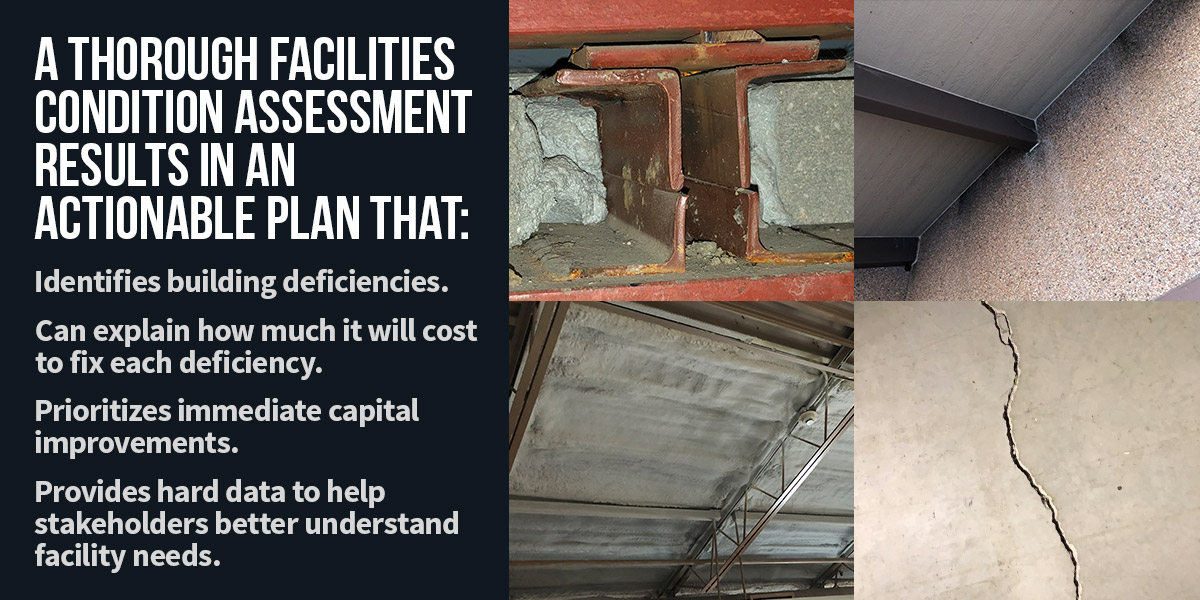Michelle Klobassa recently climbed to a building’s roof to discover a problem that, if left unchecked, will cause serious issues not too many years ahead. Leaves, pebbles and dirt have blocked many of the roof drains. Unless the debris is cleared away, rainwater will pond on the roof and cause major damage and the need for a replacement ahead of schedule.
The building’s owner now can clear the drains in what is a simple, effective solution. However, not all problems uncovered in the ongoing facilities condition assessment, or FCA, likely will prove to be as inexpensively or easily solved. Uncovering any issues early, however, allows the owner to plan for expenses, make budget decisions or tackle priorities in an orderly way.
“Facilities condition assessments can help building owners understand any problem areas that they may or may not be aware of,” said Klobassa, an architect with TSP Inc.
The insights provided through such assessments, feasibility studies and master planning assistance are always in demand, but the multidisciplinary firm of architects, engineers and interior designers is seeing an increase in such requests as people anticipate the end of the COVID-19 pandemic. Preparation for the future today will help places such as schools, churches and businesses be ready for a return to increased activity.
“This takes a bigger-picture view of a facility and establishes a vision for the future,” Klobassa said. “We are seeing many requests for this type of service right now, which shows that our clients are actively thinking about how their buildings need to adapt to their current and long-term needs even in the midst of a pandemic.”
That’s part of what Klobassa’s team is doing on its facilities condition assessment for a church. As the architects and engineers proceed, they will examine items such as windows, brick, lighting and HVAC systems. Based on the visible condition, age and performance, the FCA team from TSP assigned to the project will advise replacement or continued usage. A long-term replacement plan allows officials to prepare a budget that is less likely to be affected by an unforeseen event.
“As any homeowner knows, it’s expensive to call in a plumber on a Saturday night when it’s an emergency,” TSP architect Sean Ervin said. “Planned maintenance is always much more cost effective.”
A feasibility study goes beyond generic assessment of a deteriorating building, Ervin said. It tells the owner if the building is being used correctly and answers the question, “If we expand, what do we want?”
Master-planning assistance provides more design-focused preparations for potential renovations or additions to an existing building or for a new facility. Clients interested in purchasing a building may request an assessment, even of a relatively new facility, to make sure the current owner took proper care of it.
“You may not be aware of things the owner didn’t take care of or not know if it was designed in the best way,” TSP structural engineer Lucas Lorenzen said of a potential buyer. “When we examine the full scope of a building envelope, we may identify any issues that may be suspect.”
Building owners may not realize a 20-year-old mechanical system could last for 60 years, he said. They may be unaware proper roof maintenance can extend its life for five years, allowing time to save money before replacing it entirely. Lorenzen compares it to wellness visits that medical clinics offer children.
“It’s better to identify big issues ahead of time versus trying to take care of an issue after it emerges. Cleaning a roof costs pennies when compared to spending thousands on a drainage-backup issue. An assessment might find some issues that can be addressed.”
Both paper documents and personal experience are collected during building assessments. The team looks at any original drawings, the owner’s records of what work has taken place and what can be seen during a visual inspection. It goes beyond that, Ervin said.
“There are times when we ask the occupants, ‘Have you seen that? Have you seen this? What was it like when it was 98 degrees outside?’ ” Ervin said. “In the electrical and mechanical assessment, we ask questions like, ‘Have you noticed if the lights get dim?’ We want to talk to occupants who are familiar with the building.”
An assessment or feasibility study can give owners an in-depth education on their building, Lorenzen said. If they are considering an expansion, he helps them understand the process and what steps to take.
“It’s an education for the owner to understand what they need to focus on,” Lorenzen said. “They have better information than when they started talking about a big project. Most owners learn something they wish they knew before they got started.”
Last year, Ervin worked with a client interested in purchasing and repurposing a former school building. After a facilities condition assessment, the owner decided the building would not serve his purposes. Lorenzen worked with a businessman considering adding a second story to his building. A deep dive into the building’s structure and the city code requirements determined it would not be feasible.
“We could tell him that codewise he couldn’t go over the square footage without making certain changes,” Lorenzen said. “And you can’t add a second story to a building that was not designed to hold one. The owner often has a vision of something, but we try and look at the big show-stoppers to that idea.”
Sometimes, the owner’s vision does come true, and it can be tied into a master plan that looks to the future. The TSP team performing the assessment always looks for the highest and best use of a facility.
“Just because the gym is the size it is doesn’t mean it’s the best competition gym,” Ervin said. “Maybe it could be repurposed into a multipurpose space because it would be good enough for a different function. Maybe they’re growing, and they won’t be able to use the current gym much longer. Longer-term consideration is always worthwhile.”
No building can last for decades without proper maintenance and a vision for the future. A proactive facility assessment helps prioritize what steps to take next.
“We help building owners be more proactive through our observations of the building’s condition,” Klobassa said. “We advise if the repairs or replacements should be done immediately, in the short term such as two to five years or further out as much as 10 years.”




